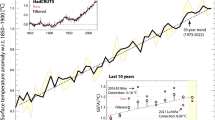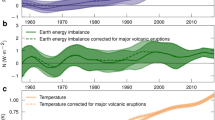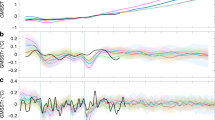Abstract
Most present-generation climate models simulate an increase in global-mean surface temperature (GMST) since 1998, whereas observations suggest a warming hiatus. It is unclear to what extent this mismatch is caused by incorrect model forcing, by incorrect model response to forcing or by random factors. Here we analyse simulations and observations of GMST from 1900 to 2012, and show that the distribution of simulated 15-year trends shows no systematic bias against the observations. Using a multiple regression approach that is physically motivated by surface energy balance, we isolate the impact of radiative forcing, climate feedback and ocean heat uptake on GMST—with the regression residual interpreted as internal variability—and assess all possible 15- and 62-year trends. The differences between simulated and observed trends are dominated by random internal variability over the shorter timescale and by variations in the radiative forcings used to drive models over the longer timescale. For either trend length, spread in simulated climate feedback leaves no traceable imprint on GMST trends or, consequently, on the difference between simulations and observations. The claim that climate models systematically overestimate the response to radiative forcing from increasing greenhouse gas concentrations therefore seems to be unfounded.
This is a preview of subscription content, access via your institution
Access options
Subscribe to this journal
Receive 51 print issues and online access
$199.00 per year
only $3.90 per issue
Buy this article
- Purchase on Springer Link
- Instant access to full article PDF
Prices may be subject to local taxes which are calculated during checkout



Similar content being viewed by others
References
Knight, J. et al. Do global temperature trends over the last decade falsify climate predictions? Bull. Am. Meteorol. Soc. 90, S22–S23 (2009)
Wang, S. et al. Does the global warming pause in the last decade: 1999–2008? Adv. Clim. Change Res. 1, 49–54 (2010)
Liebmann, B., Dole, R. M., Jones, C., Blade, I. & Allured, D. Influence of choice of time period on global surface temperature trend estimates. Bull. Am. Meteorol. Soc. 91, 1485–1491 (2010)
Hartmann, D. L. et al. in Climate Change 2013: The Physical Science Basis (eds Stocker, T. F. et al.) 159–254 (Cambridge Univ. Press, 2013)
Flato, G. et al. in Climate Change 2013: The Physical Science Basis (eds Stocker, T. F. et al.) 741–866 (Cambridge Univ. Press, 2013)
Meehl, G. A., Arblaster, J. M., Fasullo, J. T., Hu, A. & Trenberth, K. E. Model-based evidence of deep-ocean heat uptake during surface-temperature hiatus periods. Nature Clim. Change 1, 360–364 (2011)
Meehl, G. A. & Teng, H. Case studies for initialized decadal hindcasts and predictions for the Pacific region. Geophys. Res. Lett. 39, L22705 (2012)
Meehl, G. A., Hu, A., Arblaster, J. M., Fasullo, J. & Trenberth, K. E. Externally forced and internally generated decadal climate variability associated with the interdecadal Pacific oscillation. J. Clim. 26, 7298–7310 (2013)
Doblas-Reyes, F. J. et al. Initialized near-term regional climate change prediction. Nature Commun. 4, 1715 (2013)
Guemas, V., Doblas-Reyes, F. J., Andreu-Burillo, I. & Asif, M. Retrospective prediction of the global warming slowdown in the past decade. Nature Clim. Change 3, 649–653 (2013)
Fyfe, J. C., Gillett, N. P. & Zwiers, F. W. Overestimated global warming over the past 20 years. Nature Clim. Change 3, 767–769 (2013)
Santer, B. D. et al. Volcanic contribution to decadal changes in tropospheric temperature. Nature Geosci. 7, 185–189 (2014)
Risbey, J. S. et al. Well-estimated global surface warming in climate projections selected for ENSO phase. Nature Clim. Change 4, 835–840 (2014)
Huber, M. & Knutti, R. Natural variability, radiative forcing and climate response in the recent hiatus reconciled. Nature Geosci. 7, 651–656 (2014)
Solomon, S. et al. The persistently variable “background” stratospheric aerosol layer and global climate change. Science 333, 866–870 (2011)
Schmidt, G. A., Shindell, D. T. & Tsigaridis, K. Reconciling warming trends. Nature Geosci. 7, 158–160 (2014)
Stott, P., Good, P., Jones, G., Gillett, N. & Hawkins, E. The upper end of climate model temperature projections is inconsistent with past warming. Environ. Res. Lett. 8, 014024 (2013)
Bindoff, N. L. et al. in Climate Change 2013: The Physical Science Basis (eds Stocker, T. F. et al.) 867–952 (Cambridge Univ. Press, 2013)
England, M. H. et al. Recent intensification of wind-driven circulation in the Pacific and the ongoing warming hiatus. Nature Clim. Change 4, 222–227 (2014)
Cohen, J. L., Furtado, J. C., Barlow, M., Alexeev, V. A. & Cherry, J. E. Asymmetric seasonal temperature trends. Geophys. Res. Lett. 39, L04705 (2012)
Kosaka, Y. & Xie, S.-P. Recent global-warming hiatus tied to equatorial Pacific surface cooling. Nature 501, 403–407 (2013)
Lean, J. L. & Rind, D. H. How will Earth’s surface temperature change in future decades? Geophys. Res. Lett. 36, L15708 (2009)
Foster, G. & Rahmstorf, S. Global temperature evolution 1979–2010. Environ. Res. Lett. 6, 044022 (2011)
Kaufmann, R. K., Kauppi, H., Mann, M. L. & Stock, J. H. Reconciling anthropogenic climate change with observed temperature 1998–2008. Proc. Natl Acad. Sci. USA 108, 11790–11793 (2011)
Thompson, D. W. J., Wallace, J. M., Jones, P. D. & Kennedy, J. J. Identifying signatures of natural climate variability in time series of global-mean surface temperature: methodology and insights. J. Clim. 22, 6120–6141 (2009)
Santer, B. D. et al. Separating signal and noise in atmospheric temperature changes: the importance of timescale. J. Geophys. Res. 116, D22105 (2011)
Morice, C. P., Kennedy, J. J., Rayner, N. A. & Jones, P. D. Quantifying uncertainties in global and regional temperature change using an ensemble of observational estimates: the HadCRUT4 data set. J. Geophys. Res. 117, D08101 (2012)
Taylor, K. E., Stouffer, R. J. & Meehl, G. A. An overview of CMIP5 and the experiment design. Bull. Am. Meteorol. Soc. 93, 485–498 (2012)
Cowtan, K. & Way, R. G. Coverage bias in the HadCRUT4 temperature series and its impact on recent temperature trends. Q. J. R. Meteorol. Soc. 140, 1935–1944 (2014)
Simmons, A. J., Willett, K. M., Jones, P. D., Thorne, P. W. & Dee, D. P. Low-frequency variations in surface atmospheric humidity, temperature, and precipitation: inferences from reanalyses and monthly gridded observational data sets. J. Geophys. Res. 115, D01110 (2010)
Anderson, J. L. A method for producing and evaluating probabilistic forecasts from ensemble model integrations. J. Clim. 9, 1518–1530 (1996)
Easterling, D. R. & Wehner, M. F. Is the climate warming or cooling? Geophys. Res. Lett. 36, L08706 (2009)
Stroeve, J. C. et al. Trends in Arctic sea ice extent from CMIP5, CMIP3 and observations. Geophys. Res. Lett. 39, L16502 (2012)
Notz, D., Haumann, F. A., Haak, H., Jungclaus, J. H. & Marotzke, J. Arctic sea-ice evolution as modeled by Max Planck Institute for Meteorology’s Earth system model. J. Adv. Model. Earth Syst. 5, 173–194 (2013)
Forster, P. M. et al. Evaluating adjusted forcing and model spread for historical and future scenarios in the CMIP5 generation of climate models. J. Geophys. Res. 118, 1–12 (2013)
Gregory, J. M. & Forster, P. M. Transient climate response estimated from radiative forcing and observed temperature change. J. Geophys. Res. 113, D23105 (2008)
Held, I. M. et al. Probing the fast and slow components of global warming by returning abruptly to preindustrial forcing. J. Clim. 23, 2418–2427 (2010)
Andrews, T., Gregory, J. M., Webb, M. J. & Taylor, K. E. Forcing, feedbacks and climate sensitivity in CMIP5 coupled atmosphere-ocean climate models. Geophys. Res. Lett. 39, L09712 (2012)
Kuhlbrodt, T. & Gregory, J. M. Ocean heat uptake and its consequences for the magnitude of sea level rise and climate change. Geophys. Res. Lett. 39, L18608 (2012)
Vial, J., Dufresne, J.-L. & Bony, S. On the interpretation of inter-model spread in CMIP5 climate sensitivity estimates. Clim. Dyn. 41, 3339–3362 (2013)
Gregory, J. M. et al. A new method for diagnosing radiative forcing and climate sensitivity. Geophys. Res. Lett. 31, L03205 (2004)
Block, K. & Mauritsen, T. Forcing and feedback in the MPI-ESM-LR coupled model under abruptly quadrupled CO2 . J. Adv. Model. Earth Syst. 5, 676–691 (2013)
Meraner, K., Mauritsen, T. & Voigt, A. Robust increase in equilibrium climate sensitivity under global warming. Geophys. Res. Lett. 40, 5944–5948 (2013)
Forster, P. et al. in Climate Change 2007: The Physical Science Basis. (eds Solomon, S. et al.) 129–234 (Cambridge Univ. Press, 2007)
Santer, B. D. et al. Identifying human influences on atmospheric temperature. Proc. Natl Acad. Sci. USA 110, 26–33 (2013)
Myhre, G. et al. in Climate Change 2013: The Physical Science Basis. (eds Stocker, T. F. et al.) 659–740 (Cambridge Univ. Press, 2013)
Fyfe, J. C., von Salzen, K., Cole, J. N. S., Gillett, N. P. & Vernier, J. P. Surface response to stratospheric aerosol changes in a coupled atmosphere-ocean model. Geophys. Res. Lett. 40, 584–588 (2013)
Ridley, D. A. et al. Total volcanic stratospheric aerosol optical depths and implications for global climate change. Geophys. Res. Lett. 41, 7763–7769 (2014)
Acknowledgements
We are indebted to J. Fyfe for making his CMIP5 GMST data set available to us, and to D. Notz, J. Risbey and B. Santer for comments on the manuscript. We acknowledge the World Climate Research Programme’s Working Group on Coupled Modelling, which is responsible for CMIP, and we thank the climate modelling groups (names of models listed in Extended Data Table 1) for producing and making available their model output. For CMIP the US Department of Energy’s Program for Climate Model Diagnosis and Intercomparison provides coordinating support and led development of software infrastructure in partnership with the Global Organization for Earth System Science Portals. This work was supported by the Max Planck Society for the Advancement of Science (J.M.) and by a Royal Society Wolfson Merit Award and EPSRC grant EP/1014721/1 (P.M.F.).
Author information
Authors and Affiliations
Contributions
The authors jointly designed the study. J.M. analysed the data and wrote the manuscript. Both authors discussed the results and the manuscript.
Corresponding author
Ethics declarations
Competing interests
The authors declare no competing financial interests.
Extended data figures and tables
Extended Data Figure 1 Observed and simulated time series of the anomalies in annually averaged GMST, from 1900 to 2012.
All anomalies are differences from the 1961–1990 temporal mean of each individual time series. GMST is the globally averaged merged surface temperature (2 m height over land and surface temperature over the ocean). The figure shows single simulations for the CMIP5 models (thin lines), the multimodel ensemble mean (thick red line) and the HadCRUT427 observations (thick black line). All model results have been subsampled using the HadCRUT4 observational data mask11. a, 114 realizations from the CMIP5 archive, obtained with 36 different models. b, Subset of 75 realizations with the 18 different models for which information on ERF is available35 (Extended Data Table 1). The two model ensembles are nearly indistinguishable.
Extended Data Figure 2 Time series of trends in ERF, as a function of start year.
a, 15-year trends; b, 62-year trends. Thin coloured lines show individual models as diagnosed previously35; if multiple realizations were available for a model, then the ensemble average of the individual diagnosed ERF time series for that model was given35 and is shown here. The thick red line shows the ensemble average over all models. The thick black line shows the best estimate from AR546, including, for illustration, the 5–95% uncertainty range for the periods 1984–1998 (a) and 1951–2011 (b), taken from fig. 8.19 in ref. 46. These uncertainty ranges, both of which are around 0.2 W m−2 per decade, do not take into account observational biases such as those diagnosed in ref. 48. Despite the scatter of the CMIP5 ensemble trends, the ensemble mean is in good agreement with the AR5 best estimate for almost all start years. The AR5 best-estimate ERF sums time series of forcing across individual forcing terms. Individual time series of AR5 ERF were derived in different ways. Greenhouse gas concentrations (observed or inferred), stratospheric aerosol optical depth and total solar irradiance were used to derive estimates of radiative forcing using simple formulae. Surface albedo forcing was derived from estimated anthropogenic vegetation trends. Ozone and aerosol forcings were derived from chemical transport model results with aspects of the forcing constrained by other modelling approaches or observations, or both. ERF sums rapid adjustments with traditional radiative forcings. Most time series in AR5 were based on traditional radiative forcings, and only CO2 and aerosol forcings included an assessment of the rapid adjustment. In other cases ERF and radiative forcings were assumed to be the same. The AR5 ERF for the most recent 2000–2011 period included updated estimates of volcanic and solar forcing, taking into account the broader 2008–2009 solar minimum and post-2000 volcanic activity46. These two cooling influences are not included in the CMIP5 ERF; it is hence surprising and unexplained why the CMIP5 ensemble-mean of 15-year ERF trends lies below the best-estimate AR5 ERF trend for the latest start years in a.
Extended Data Figure 3 Joint relative frequency distribution as a function of GMST trend and ERF trend, for the reduced 75-member ensemble for which forcing information is available and all start years.
a, 15-year trends; bin sizes are 0.025 °C per decade and 0.05 W m−2 per decade for GMST and ERF trend, respectively. b, 62-year trends; bin sizes are 0.0125 °C per decade and 0.025 W m−2 per decade for GMST and ERF trend, respectively. The ‘climate resistance’, ρ, is given by ρ = α + κ (refs 35, 36, 37). Each joint distribution is normalized such that its area integral is unity. Note the different axes, reflecting the much tighter correlation of the 62-year trends.
Extended Data Figure 4 Regression-based 15-year GMST trends since 1900.
a, Joint relative frequency distribution of regression result (equation (4) minus the ensemble-mean trend) as a function of start year and trend size. The P values of the regression have a median across start years of 0.075, based on the null hypothesis that all regression coefficients are zero. b, Joint relative frequency distribution of regression contribution from the trend in ERF. c, Joint relative frequency distribution of regression contribution from the climate feedback parameter α. d, Joint relative frequency distribution of regression contribution from the ocean heat uptake efficiency κ. In all joint relative frequency distributions, GMST trend is collected in bins of 0.025 °C per decade, and each vertical cross section is normalized such that its area integral is unity.
Rights and permissions
About this article
Cite this article
Marotzke, J., Forster, P. Forcing, feedback and internal variability in global temperature trends. Nature 517, 565–570 (2015). https://doi.org/10.1038/nature14117
Received:
Accepted:
Published:
Issue Date:
DOI: https://doi.org/10.1038/nature14117
This article is cited by
-
The significant influence of the Atlantic multidecadal variability to the abrupt warming in Northeast Asia in the 1990s
npj Climate and Atmospheric Science (2024)
-
Sensitivity of extreme precipitation to climate change inferred using artificial intelligence shows high spatial variability
Communications Earth & Environment (2023)
-
Modern temperatures in central–north Greenland warmest in past millennium
Nature (2023)
-
Drivers of accelerated warming in Mediterranean climate-type regions
npj Climate and Atmospheric Science (2023)
-
Evaluating historical climate extremes in the FGOALS-g3 large ensemble in the presence of internal climate variability
Climate Dynamics (2023)
Comments
By submitting a comment you agree to abide by our Terms and Community Guidelines. If you find something abusive or that does not comply with our terms or guidelines please flag it as inappropriate.



